Lower-star Filtrations¶
A lower-star filtration on a simplicial complex \(X\) is a filtration extended from a function on the vertex set \(f: X_0\to \mathbb{R}\). The lower-star filtration of \(X\) at parameter \(a\) is the maximal sub-complex of \(X\) on the inverse image
The parameter at which a simplex \((x_0,\dots,x_k)\in X\) appears at is
Application to images¶
A common use of lower-star filtrations is to building filtrations on images using pixel values.
[1]:
import numpy as np
import matplotlib.pyplot as plt
n = 100
img = np.empty((n,n))
def rad(i,j, n):
return np.sqrt((i - n/2)**2 + (j - n/2)**2)
for i in range(n):
for j in range(n):
# print(i,j, rad(i,j,n))
img[i,j] = 1-np.exp(-(rad(i,j,n) - 20)**2/100)
plt.imshow(img, cmap='bone')
plt.show()
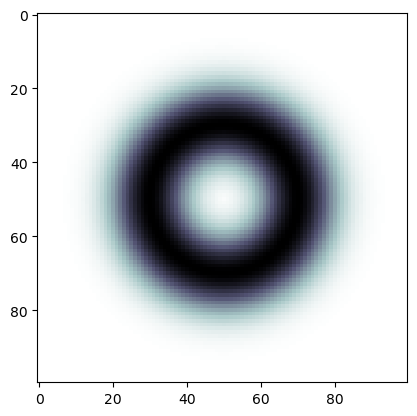
This image is a function on the square discretized into pixels. We can build a simplicial complex which triangulates the square with vertices (0-simplices) identified with the pixels using the Freudenthal triangulation.
[2]:
import bats
m = 5
X = bats.Freudenthal(m, m)
xx, yy = np.meshgrid(np.arange(m), np.arange(m))
xx = xx.flatten()
yy = yy.flatten()
fig, ax = plt.subplots()
# scatter vertices
ax.scatter(xx, yy, c='b')
# plot edges
for e in X.get_simplices(1):
ax.plot(xx[e], yy[e], c='b')
ax.set_title("Freudenthal triangulation of {0} x {0} gird".format(m))
ax.set_aspect('equal')
plt.show(fig)
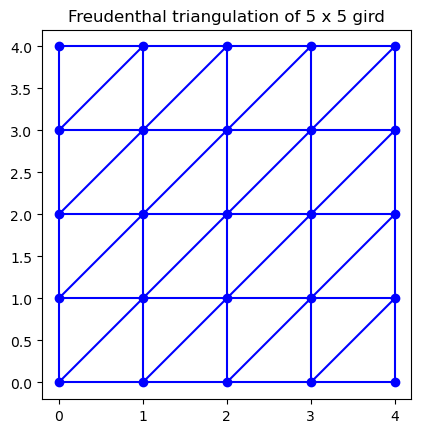
To compute the lower-star filtration, we can use bats.lower_star_filtration, which returns the filtration value for each simplex as well as a map back to the largest value vertex in the simplex.
[3]:
X = bats.Freudenthal(n, n)
vals, imap = bats.lower_star_filtration(X, img.flatten()) # computes filtration parameter to
F = bats.Filtration(X, vals)
We can visualize the filtration on vertices:
[4]:
def show_sublevel(ax, F, alpha, xx, yy):
"""
visualize the sublevelset (-inf, alpha]
"""
Xa = F.sublevelset(alpha)
ax.scatter(xx, yy, color=(0,0,1,0.01))
# 0-simplices
X0 = Xa.get_simplices(0)
ax.scatter(xx[X0], yy[X0], color=(0,0,1,1))
ax.set_title(r"$f^{{-1}}((-\infty, {}])$".format(alpha))
alphas = [0.2, 0.5, 0.8, 1.0]
fig, axs = plt.subplots(1, len(alphas), figsize = (5*len(alphas), 5))
xx, yy = np.meshgrid(np.arange(n), np.arange(n))
xx = xx.flatten()
yy = yy.flatten()
for ax, alpha in zip(axs, alphas):
show_sublevel(ax, F, alpha, xx, yy)
plt.show(fig)

And compute persistent homology
[5]:
RF = bats.reduce(F, bats.F2())
ps = RF.persistence_pairs(0) + RF.persistence_pairs(1)
bats.persistence_diagram(ps)
plt.show()

We see a prominent \(H_1\) pair corresponding to the annulus
[6]:
for p in ps:
if p.length() > 0.5:
print(p)
0 : (0,inf) <3050,-1>
1 : (0.00378158,0.981684) <20537,10001>
Visualization¶
Homology Generators¶
You can extract homology generators from a ReducedFilteredChainComplex, the output of bats.reduce.
Let’s look at a new image with several long bars in \(H_0\) and \(H_1\)
[7]:
img2 = np.empty((n,n))
for i in range(n):
for j in range(n):
img2[i,j] = np.sin(4*np.pi*i/n) + np.cos(4*np.pi*j/n)
plt.imshow(img2, cmap='bone')
plt.show()

[8]:
vals, imap = bats.lower_star_filtration(X, img2.flatten()) # computes filtration parameter to
F = bats.Filtration(X, vals)
alphas = [-1.0, -0.25, 0.25, 1.0]
fig, axs = plt.subplots(1, len(alphas), figsize = (5*len(alphas), 5))
xx, yy = np.meshgrid(np.arange(n), np.arange(n))
xx = xx.flatten()
yy = yy.flatten()
for ax, alpha in zip(axs, alphas):
show_sublevel(ax, F, alpha, xx, yy)
plt.show(fig)

[9]:
RF = bats.reduce(F, bats.F2())
ps = RF.persistence_pairs(0) + RF.persistence_pairs(1)
bats.persistence_diagram(ps)
plt.show()
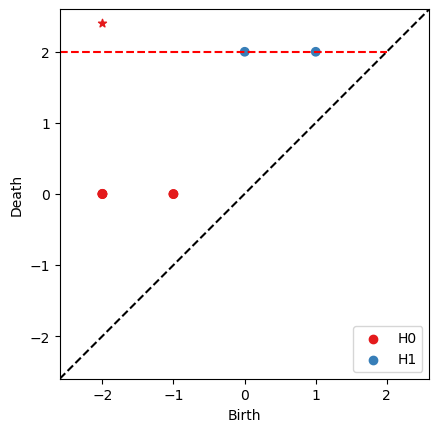
[10]:
nzps = [p for p in ps if p.length() > 0]
for p in nzps:
print(p)
0 : (-1.99803,inf) <3725,-1>
0 : (-1.99803,0.00197327) <3775,10979>
0 : (-1.99803,-0.00197327) <8825,18948>
0 : (-1.99803,-0.00197327) <8875,19098>
0 : (-1,-0.00197327) <51,4048>
0 : (-1,-0.00197327) <151,4198>
1 : (0.00197327,1.99803) <26177,12575>
1 : (1,1.99803) <203,2675>
[11]:
# visualization of representatives
plt.imshow(img2, origin='upper', cmap='bone')
for pi, p in enumerate(nzps):
c = RF.representative(p, False)
d = p.dim()
supp = np.unique([X.get_simplex(d, i) for i in c.nzinds()])
xx = supp % n
yy = supp // n
if p.dim() == 0:
marker='x'
else:
marker='.'
plt.scatter(xx[:],yy[:],marker=marker,label="H{}, #{}".format(d, pi))
plt.legend(bbox_to_anchor=(1.05, 1), loc='upper left')
plt.show()

Critical Simplices¶
Critical simplices are the simplices whose addition to the filtration causes a homology class to be born or killed.
Lower-star filtrations provide an inverse map back to the pixel which gave the critical simplex its filtration value. This is the imap which we computed in vals, imap = bats.lower_star_filtration(...)
[12]:
p = nzps[-2]
d = p.dim()
plt.imshow(img2, cmap='bone')
# representative
c = RF.representative(p)
supp = np.unique([X.get_simplex(d, i) for i in c.nzinds()])
xx = supp % n
yy = supp // n
plt.scatter(xx[:],yy[:],c='b',label="rep")
bskel = np.array([imap[d][p.birth_ind()]])
xx = bskel % n
yy = bskel // n
plt.scatter(xx[:],yy[:], c='r', marker='^', label="birth")
if p.death_ind() != 18446744073709551615:
dskel = np.array([imap[d+1][p.death_ind()]])
xx = dskel % n
yy = dskel // n
plt.scatter(xx[:],yy[:], c='r', marker='x', label="death")
plt.legend(bbox_to_anchor=(1.05, 1), loc='upper left')
plt.show()
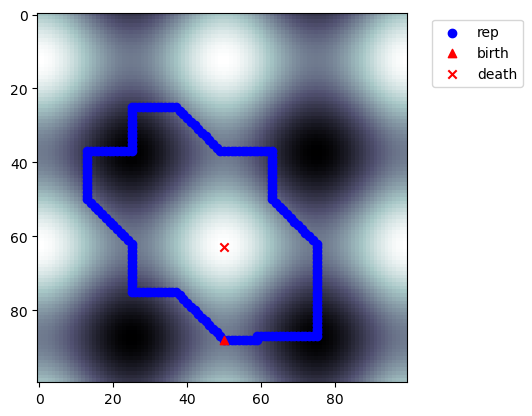
Non-Uniqueness of Generators¶
Homology generators are not unique, as we can add any element of \(\mathop{img} \partial_{k+1}\) to a representative of \(H_k\) and stay in the homology class. However, the critical simplices will be the same.
This behavior can be seen using different reduction options in BATS.
[13]:
RF = bats.reduce(F, bats.F2(), bats.standard_reduction_flag(), bats.clearing_flag(), bats.compute_basis_flag())
ps = RF.persistence_pairs(0) + RF.persistence_pairs(1)
bats.persistence_diagram(ps)
plt.show()

[14]:
nzps = [p for p in ps if p.length() > 0]
p = nzps[-2]
d = p.dim()
plt.imshow(img2, cmap='bone')
# representative
c = RF.representative(p)
supp = np.unique([X.get_simplex(d, i) for i in c.nzinds()])
xx = supp % n
yy = supp // n
plt.scatter(xx[:],yy[:],c='b',label="rep")
bskel = np.array([imap[d][p.birth_ind()]])
xx = bskel % n
yy = bskel // n
plt.scatter(xx[:],yy[:], c='r', marker='^', label="birth")
if p.death_ind() != 18446744073709551615:
dskel = np.array([imap[d+1][p.death_ind()]])
xx = dskel % n
yy = dskel // n
plt.scatter(xx[:],yy[:], c='r', marker='x', label="death")
plt.legend(bbox_to_anchor=(1.05, 1), loc='upper left')
plt.show()

Cubical Complexes¶
Lower-star filtrations can be applied to cubical complexes as well (the inverse map is not computed)
[15]:
X = bats.Cube(n,n)
vals = bats.lower_star_filtration(X, img)
F = bats.Filtration(X, vals)
[16]:
RF = bats.reduce(F, bats.F2())
ps = RF.persistence_pairs(0) + RF.persistence_pairs(1)
bats.persistence_diagram(ps)
plt.show()
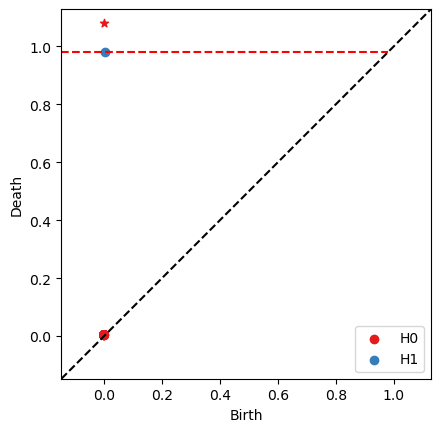
[17]:
for p in ps:
if p.length() > 0.5:
print(p)
0 : (0,inf) <3050,-1>
1 : (0.00378158,0.981684) <13747,5000>